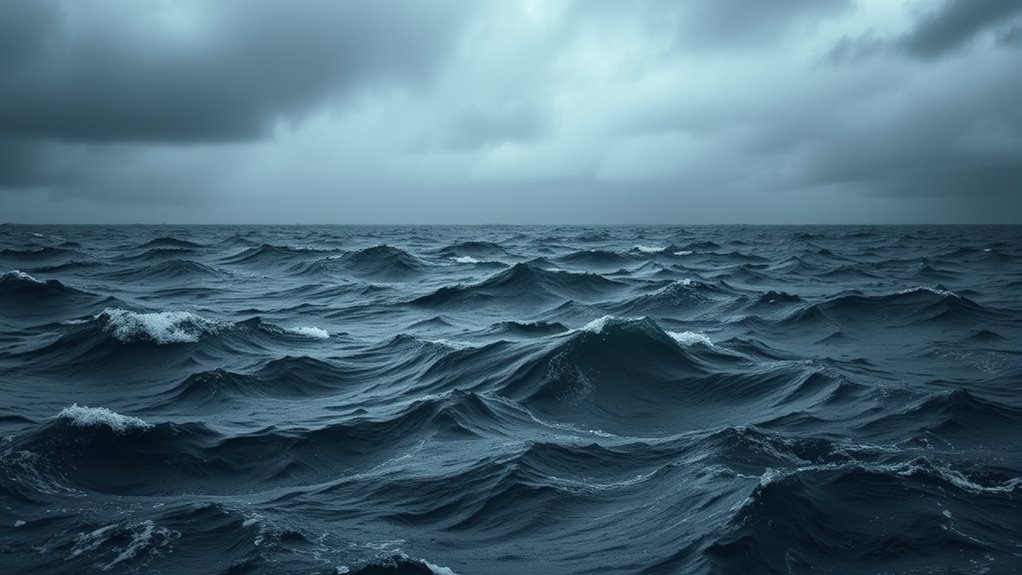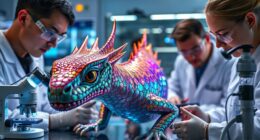Climate change is drastically altering marine habitats, pushing species to adapt, migrate, or face extinction. These rapid changes can lead to new evolutionary processes, possibly creating unique or even mythical-like creatures. As ocean currents shift and environments become more unstable, some new species might resemble stories of legendary sea monsters. If you want to explore how science explains these transformations and what the future holds for marine life, there’s more to discover.
Key Takeaways
- Climate change may drive the evolution of new, uniquely adapted marine species, but not mythical monsters.
- Deep sea discoveries reveal bioluminescent and ancient species, hinting at potential new marine life forms.
- Habitat alterations and environmental pressures can lead to rapid evolution and divergence of species.
- Changes in ocean conditions might foster the emergence of novel species with unusual traits.
- Myths of sea monsters lack scientific basis; climate change is unlikely to create legendary creatures.
How Climate Change Is Altering Marine Habitats
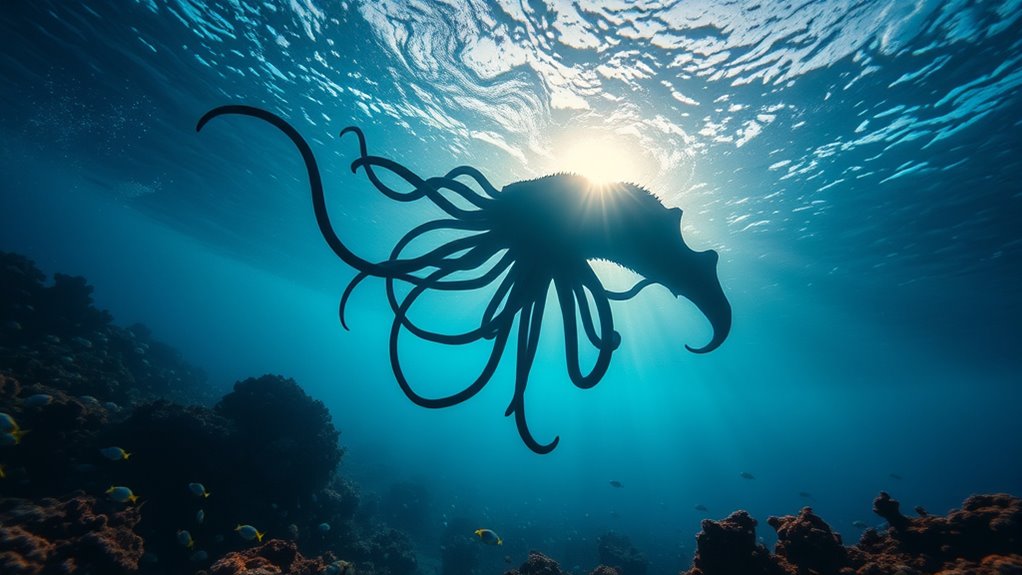
As climate change accelerates, it directly impacts marine habitats in ways you can’t ignore. Coral bleaching occurs when rising sea temperatures stress corals, causing them to expel the algae that give them color and nutrients. Without these algae, corals turn white and become vulnerable to disease. At the same time, ocean acidification—caused by increased carbon dioxide absorption—weakens coral skeletons and other marine structures. This makes habitats less stable and less hospitable for countless species. These changes threaten the biodiversity of our oceans and disrupt the delicate balance of marine ecosystems. You may not see these effects directly, but they ripple through the entire food chain, affecting fisheries, coastal communities, and the health of the planet as a whole.
The Impact of Rising Temperatures on Marine Species
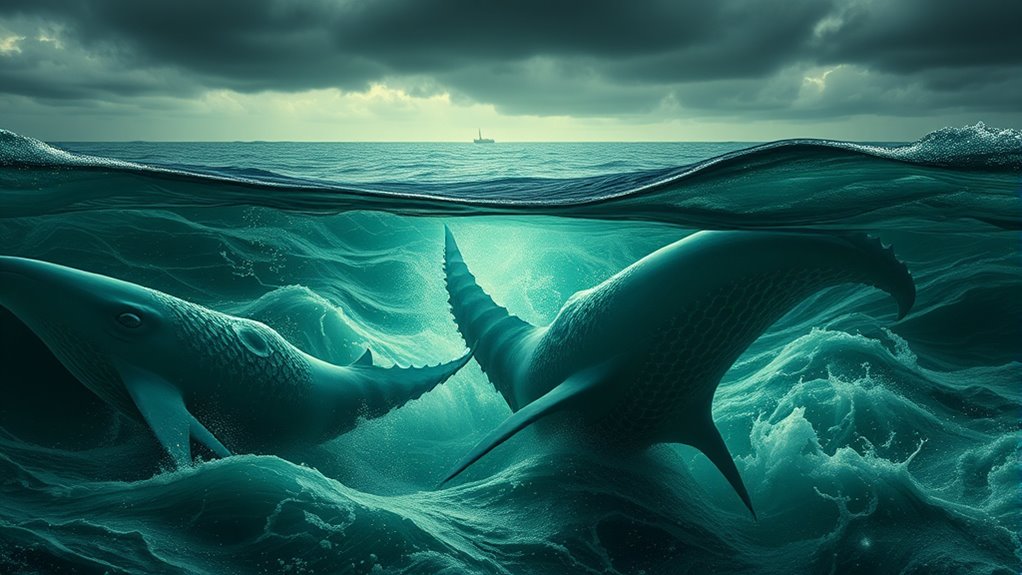
Rising ocean temperatures have a profound effect on marine species, forcing many to adapt, migrate, or face extinction. Deep sea megafauna, once stable in cold depths, now encounter shifting habitats and food sources. Marine adaptation becomes crucial as species seek cooler waters or alter their behaviors. You might imagine a large squid or whale navigating unfamiliar territories, struggling to survive. The table below illustrates these changes:
| Species Type | Response to Temperature Rise |
|---|---|
| Deep Sea Megafauna | Migration to cooler depths or decline |
| Coral Reefs | Bleaching and loss of habitat |
| Small Fish | Altered breeding cycles |
These adaptations highlight the resilience—and vulnerability—of marine life as temperatures climb.
Shifting Ocean Currents and Their Role in Species Distribution
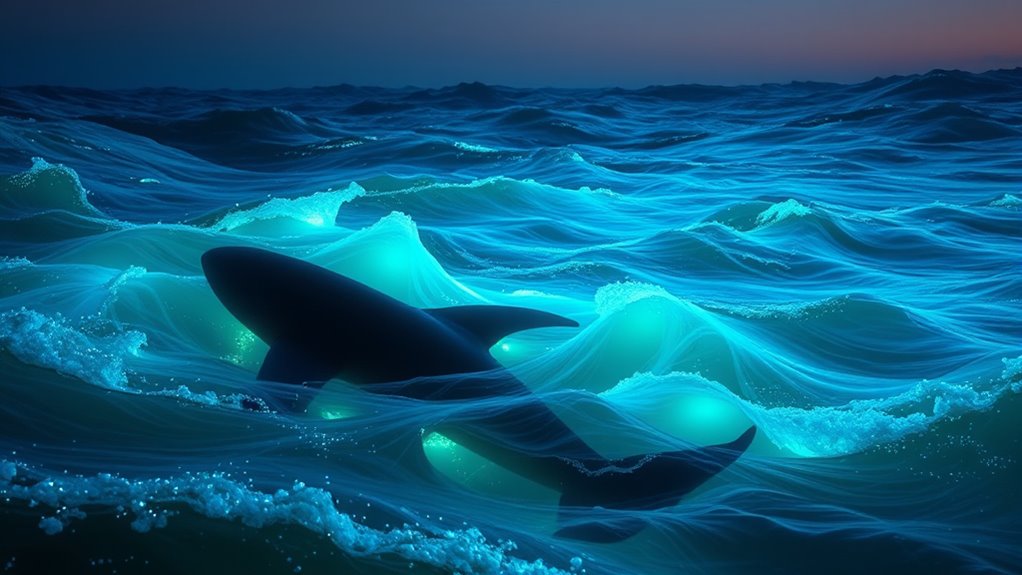
Shifting ocean currents play a significant role in altering the distribution of marine life in a warming world. As currents change, species must adapt their migratory patterns, sometimes moving toward new habitats. This can impact deep sea vents, which rely on stable conditions, causing organisms to relocate or face decline. Changes in currents also influence nutrient flow, affecting food availability across different regions. Here are three key effects:
- Migratory patterns shift, leading to new species interactions.
- Deep sea vent communities mayface displacement or extinction.
- Nutrient distribution becomes uneven, impacting growth zones.
Potential for New Species to Evolve in Changing Environments
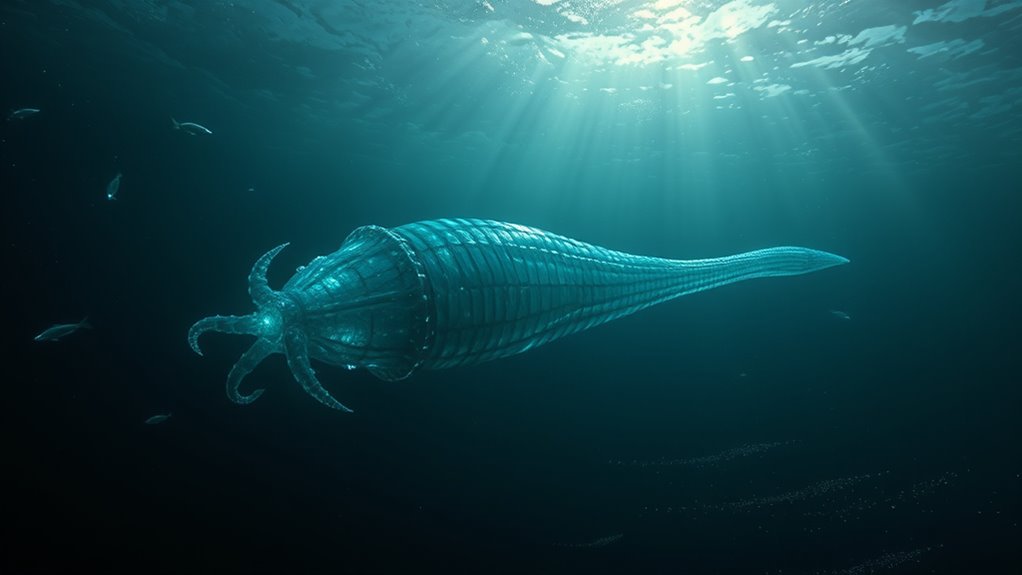
As climate change creates new habitats, you’ll see species face fresh evolutionary pressures. These changes can lead to increased genetic diversity as organisms adapt to harsh or shifting environments. This process might give rise to entirely new species better suited for the evolving ocean landscape.
New Habitats Formation
Changing climates are creating new habitats that can serve as breeding grounds for emerging species. As ocean temperatures rise, coral bleaching transforms vibrant reefs into barren landscapes, forcing marine life to seek new environments. Simultaneously, deep sea vents become more essential, providing stable, heat-rich zones where life can thrive despite surface changes. These shifts open opportunities for species to adapt or evolve in previously uninhabitable areas.
Here are three ways these habitats influence new species:
- Coral bleaching forces species to migrate or adapt to survive.
- Deep sea vents offer refuge for organisms resistant to extreme conditions.
- New habitats increase genetic diversity, fostering evolution in isolated environments.
Evolutionary Pressure Shifts
When environmental conditions transform rapidly, species face new selective pressures that can accelerate evolutionary processes. You might see organisms develop novel adaptation mechanisms to survive in changing habitats, such as altered temperature tolerances or shifted feeding strategies. These pressures influence evolutionary pathways, guiding species toward new traits that better suit the evolving environment. As ocean conditions shift due to climate change, some species may follow accelerated adaptation mechanisms, leading to rapid evolution. This process can produce entirely new traits or even new species over relatively short timeframes. In these dynamic settings, natural selection favors individuals best equipped to handle stressors like warmer waters or acidification, increasing the likelihood of unique evolutionary outcomes. You’re witnessing evolution in action, driven by the urgent need to adapt to a rapidly changing ocean.
Genetic Diversity Expansion
Have you ever wondered how environmental upheavals can lead to the emergence of entirely new species? Climate change can boost genetic diversity within populations, giving species more options for adaptation. This increased genetic variation helps organisms survive in unpredictable environments. When conditions shift rapidly, species with broader genetic diversity can develop new traits more quickly, fueling evolution. Here’s how it works:
- Genetic diversity provides a broader pool of traits for natural selection to act upon.
- Species adaptation accelerates as populations respond to changing conditions.
- New species may emerge when distinct genetic groups diverge over time.
Myth vs. Reality: Are New Sea Monsters Plausible?
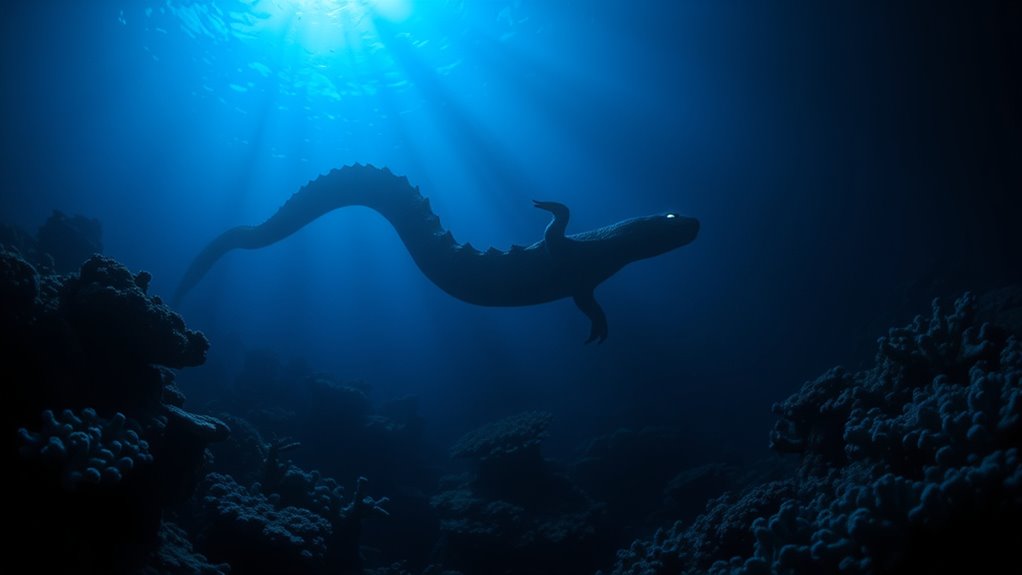
Is it possible that new sea monsters still lurk deep beneath the waves? Many believe that deep sea mysteries hide creatures we’ve only dreamed of, fueling myths of mythical creatures. However, modern science suggests otherwise. While the ocean’s depths are vast and largely unexplored, the idea of entirely new, monstrous beings emerging due to climate change isn’t highly plausible. Most sightings of supposed sea monsters are misidentifications of known marine animals or natural phenomena. The deep sea is extreme, but it’s not a breeding ground for mythical creatures or monsters in the traditional sense. Instead, it’s a frontier for scientific discovery, revealing strange but real animals adapted to extreme conditions. So, the myth of new sea monsters remains largely a mesmerizing story rather than a scientific reality.
Scientific Discoveries: Uncovering Unknown Marine Creatures
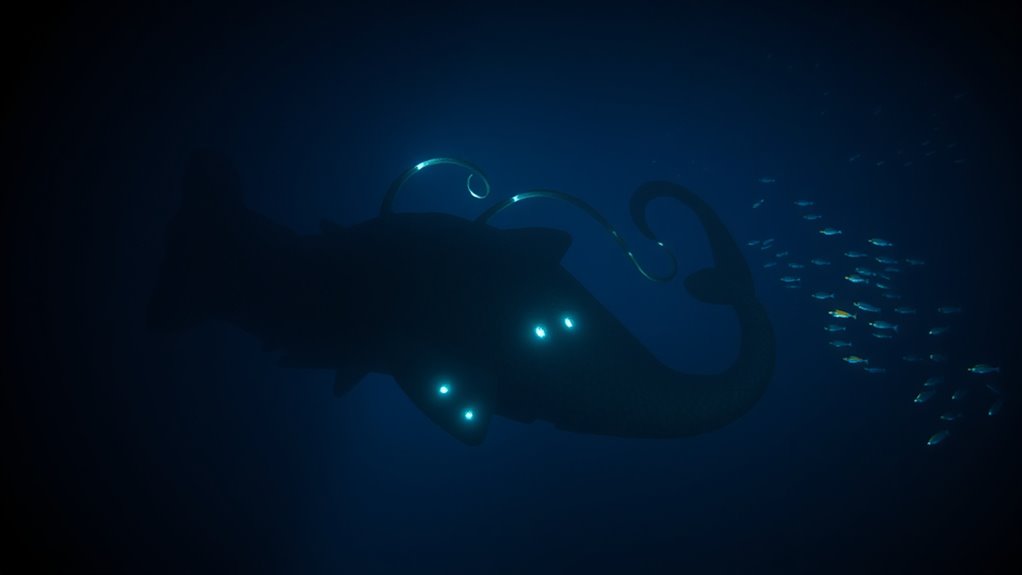
Scientific discoveries continue to surprise us with the discovery of previously unknown marine creatures, revealing how much remains hidden beneath the ocean’s surface. Recent advances have uncovered astonishing examples like deep sea bioluminescent animals that glow in the darkness, providing insights into survival strategies in extreme environments. Additionally, marine fossil discoveries reveal ancient species, helping us understand evolutionary changes over millions of years. Here are some exciting developments:
Deep-sea bioluminescent animals and ancient fossils reveal secrets of Earth’s hidden marine world.
- Bioluminescent creatures, such as anglerfish and jellyfish, illuminate deep-sea habitats, showcasing nature’s adaptation to darkness.
- Marine fossil discoveries reveal extinct species, offering clues about past ocean ecosystems and how they might react to current climate changes.
- Researchers continue to explore uncharted depths, hinting at the possibility of discovering completely new species that could resemble mythical sea monsters.
What the Future Holds for Marine Biodiversity
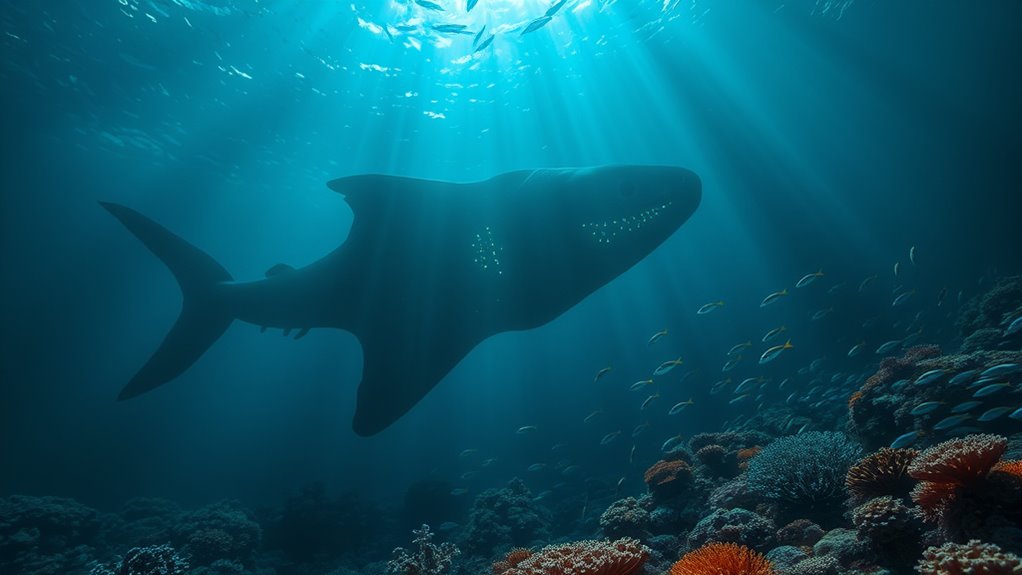
As climate change accelerates, the future of marine biodiversity hangs in the balance, with shifting temperatures and acidification threatening countless species. You’ll see changes in deep sea bioluminescence patterns as some organisms struggle to adapt, altering the mysterious glow that sustains deep ecosystems. Marine mammal migration routes will shift or become more unpredictable as warming waters disrupt traditional breeding and feeding grounds. Some species may decline or disappear, while others could emerge in new regions, creating unpredictable ecosystems. These changes could lead to a loss of biodiversity and disrupt oceanic food chains. You might witness the ocean’s vibrant life transforming rapidly, with some species thriving and others fading away, fundamentally reshaping the marine world you once knew.
Frequently Asked Questions
Could Climate Change Lead to Entirely New Marine Ecosystems?
Climate change could profoundly alter marine biodiversity and oceanic habitats, leading to the emergence of entirely new ecosystems. As temperatures rise and acidity increases, some species may adapt or migrate, while others may vanish. You might see shifts in predator-prey relationships and the formation of novel habitats, affecting the overall balance. These changes could create unforeseen marine environments, highlighting the need to understand and protect our oceanic ecosystems for future stability.
How Quickly Might New Species Adapt to Changing Ocean Conditions?
The ball’s in your court when it comes to how quickly species can adapt to changing ocean conditions. Genetic adaptation varies, and evolutionary timescales can be slow or rapid depending on the species’ reproductive rates and genetic diversity. Some organisms might keep pace with climate change, while others lag behind. You should understand that adaptation is a complex process influenced by multiple factors, making precise predictions tricky but vital for future ecosystems.
Are There Historical Precedents for Rapid Marine Species Evolution?
You wonder if rapid marine species evolution has occurred before. Historically, deep-sea environments have seen evolutionary leaps during abrupt changes, like mass extinctions. These events forced species to adapt quickly, leading to new forms and behaviors. Such precedents suggest that, as ocean conditions shift rapidly today, we might see similar evolutionary leaps, giving rise to entirely new marine species capable of thriving in changing deep-sea ecosystems.
What Role Do Deep-Sea Environments Play in Potential New Species Formation?
The deep sea is like a hidden universe teeming with potential, shaping new species through deep sea speciation. You might not realize it, but these environments hold countless unique environmental niches, fostering evolution in isolation. As conditions shift, these niches could spark rapid adaptations, making the deep sea a powerhouse for future biodiversity. So, it’s essential to understand how these dark depths influence the evolution of life on Earth.
Can Climate Change Cause Existing Marine Predators to Become More Aggressive?
Climate change can definitely cause marine predators to become more aggressive. You might notice marine behavioral changes, like increased hunting activity or territoriality, as predators adapt to shifting conditions. These changes can disrupt predator-prey dynamics, leading to more intense encounters and competition. As ocean temperatures rise and food sources become scarce, marine predators may become bolder, affecting the entire ecosystem balance you depend on and highlighting the urgency of addressing climate impacts.
Conclusion
As you see, climate change is reshaping our oceans and could lead to surprises beneath the waves. While the idea of new sea monsters makes for great stories, science shows that evolution and adaptation are more subtle but equally fascinating. Keep in mind, the ocean’s depths hold many secrets, and as the saying goes, “still waters run deep.” Stay curious, because the more we learn, the more incredible our underwater world becomes.

